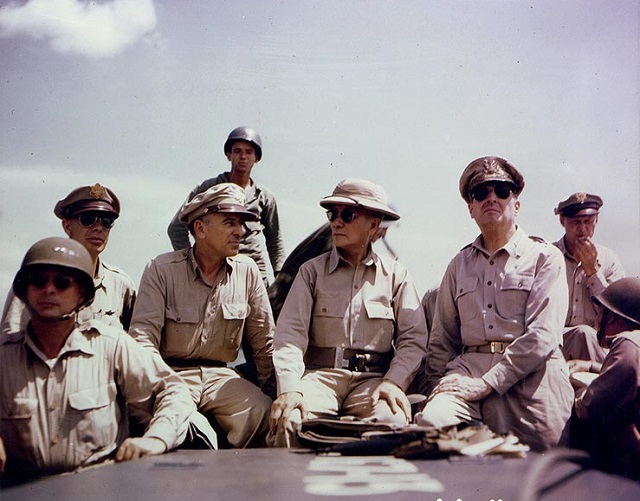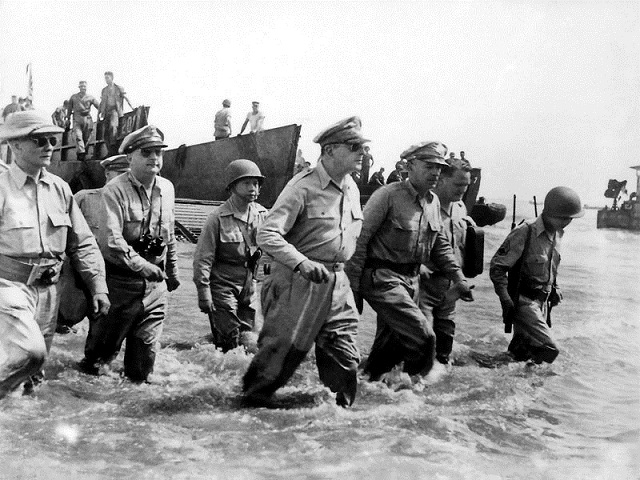Filtered By: Lifestyle
Lifestyle
General Douglas MacArthur: A man loved and hated
By VERONICA PULUMBARIT

President Sergio Osmeña and General Douglas MacArthur off Leyte, October 1944. Photo from the Naval History and Heritage Command of the US Navy
According to the Presidential Museum and Library in its timeline of the battle, "On the afternoon of 3 March Lieutenant General Oscar W. Griswold, commander of 14th Corps, reported to Gen. Krueger of 6th Army that all resistance had ceased. The survivors of the massacre of civilians in Intramuros are rescued by the Americans and taken to hospitals."
An estimated 100,000 Filipino men, women and children died in the city, which was devastated by artillery during the month-long battle.
General Douglas MacArthur, commander of the United States Army Forces in the Far East (USAFFE), had turned over control of the city to President Sergio Osmeña a few days earlier.
MacArthur, who lived from 1880 to 1964, is best remembered as the Supreme Commander of the Allied Forces in the Pacific Theater during the war.
But James Zobel, executive director of the MacArthur Library in Virginia in the United States, said there seems to be a "collective amnesia" about the man who is known as the "Liberator of the Philippines."
The American general was a man loved and hated by many, Zobel said during his recent talk at the United States Embassy in Manila on MacArthur.
He described MacArthur as an “exacting and exasperating” man who was heavily disliked by some of his colleagues in the military and yet also deeply admired by the same people.
Zobel said MacArthur was called vain, egotistical and a liar, but also a “teller of truth.”
A highly intelligent man who graduated at the top of his class at West Point, MacArthur often went against the sentiments of his fellow generals.
For one, among the US generals during the war, only MacArthur was deeply passionate about giving priority to saving the Philippines from Japan during the war.
To MacArthur, the Philippines was “home” and, thus, his entire military strategy was anchored on fulfilling his promise to return, Zobel said.
'I shall return'

US and Filipino forces land in Palo, Leyte. Photo from the Presidential Museum and Library
On April 9, 1942, less than a month after MacArthur’s departure, these same soldiers were forced to embark on the infamous “Death March” from Mariveles, Bataan to San Fernando, Pampanga, and from there to Camp O'Donnell in Capas, Tarlac—a 97-kilometer trudge in which thousands died from abuse, hunger, fatigue, injury and sickness.
Gravely disappointed that he could not immediately come to the aid of these soldiers, MacArthur issued a press statement from Australia, delivering his famous promise: “I shall return.”
For the next two and a half years, “I shall return” would be MacArthur’s mantra during his press appearances.
Zobel noted that MacArthur’s intention to return to the Philippines was met with much opposition.
America had focused its efforts on Europe, where the genocide of six million Jews was occurring. It prompted President Manuel Quezon to deliver his famous speech about the rape of Manila: "Que demonio! How typical of America to writhe in anguish at the fate of a distant cousin, Europe, while a daughter, the Philippines, is being raped in the back room!"
Zobel said MacArthur had deeply longed to return to the Philippines because it was what Quezon wanted—and Quezon was one of only two people whom the general admired and respected. The other was US President Franklin Roosevelt.
At the same US Embassy event, Ortigas Foundation Library executive director John Silva also talked about how MacArthur took on a “superman” aura to many grateful Filipinos after the liberation of the Philippines. Tales even circulated about improbable feats such as MacArthur taking on 50 Japanese soldiers in one fight.
Silva noted, however, that there were also people who expressed their displeasure at MacArthur, calling him “Dugout Doug,” implying that the general preferred to hide in a dugout instead of being at the frontlines during the war.
Zobel disputed the claim that MacArthur hid, showing photos proving that MacArthur was often at the frontline during the war.
Zobel also debunked the myth that MacArthur staged the famous photo of his landing in Palo, Leyte when he finally managed to fulfil his promise to return to the Philippines in October 1944.
“Come on, with 20,000 soldiers?” Zobel asked, adding that in fact, MacArthur was not too happy that his feet got wet during the beach landing.
Seventy years after these events took place, there are still many questions that have no answers, said Zobel.
What if the Philippines wasn’t colonized by the US? Would the US have come to the aid of the Philippines after being attacked by Japan?
What if the US government listened to the pleas of Quezon and MacArthur about the need to beef up the Philippine military before the Second World War began?
What if MacArthur became US Ambassador after the war? Would the Philippines be in a better situation because MacArthur had a great love for the country?
What if MacArthur decided not to launch artillery attacks against the Japanese during the Battle of Manila? Would Manila have remained one of the world's most beautiful cities?
Zobel said of MacArthur, “Like him or hate him, you have to admit that he led an incredible life,” adding that the general showed how one person had the power to influence history.
MacArthur also shone a light on the psychology of the soldier: “The soldier above all others prays for peace, for it is the soldier who must suffer and bear the deepest wounds and scars of war.” — BM, GMA News
More Videos
Most Popular




